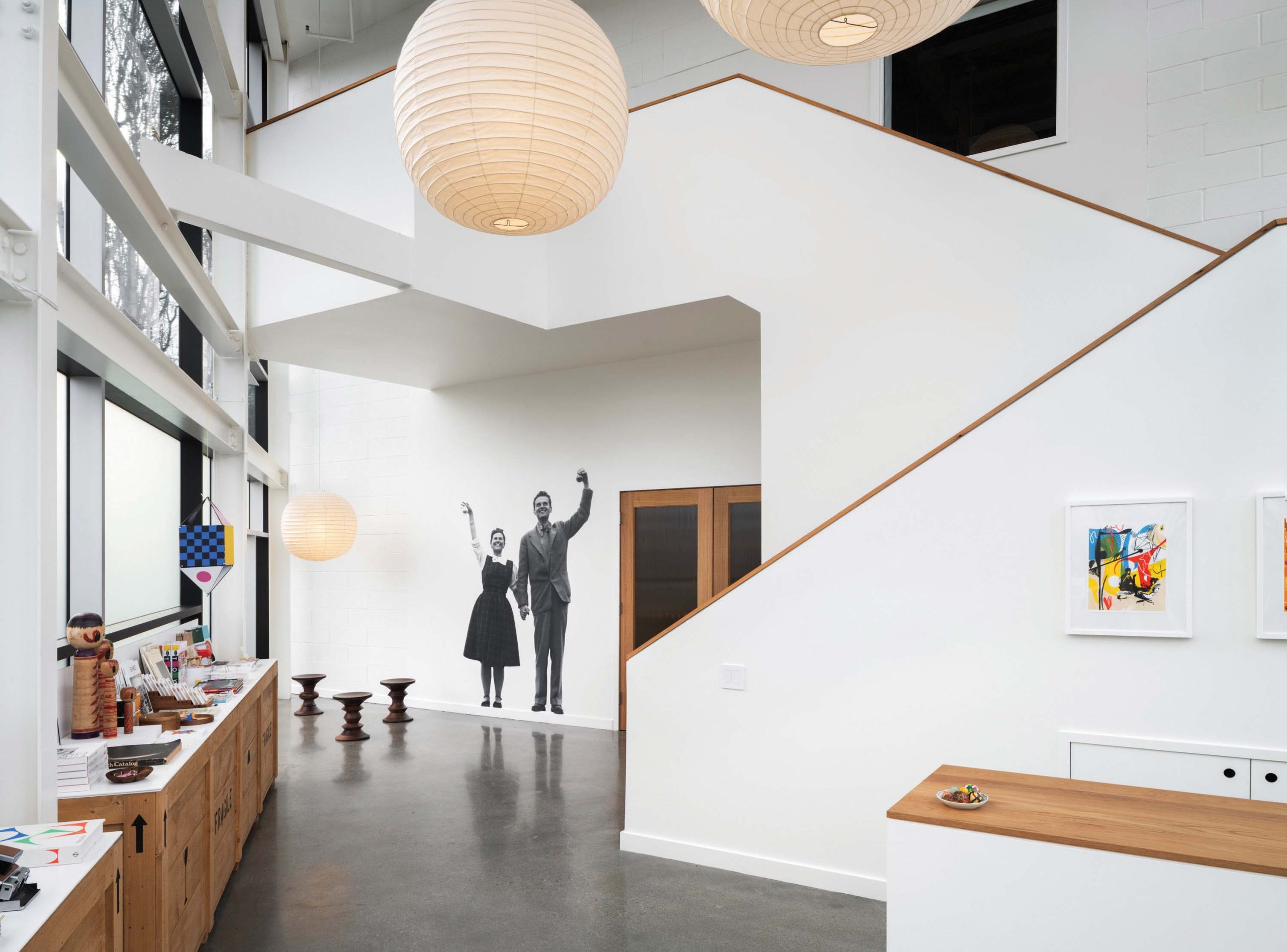
06 Sep Perspective: In the Details
If you feel any love at all for modern design of the past seven decades, chances are you’ve been moved by the work of Charles and Ray Eames. The husband-and-wife design team revolutionized not only the way furnishings looked but also how they felt and functioned. Even more ingeniously, they transformed how such now-iconic objects — from chairs and sofas to desks and storage for both homes and offices, along with an assortment of other creations from fabrics to museum exhibitions — were meticulously, painstakingly conceived, designed, and manufactured. “The details are not the details,” Ray once observed. “The details make the product.”
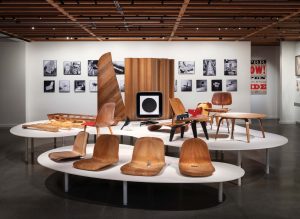
Examples of the couple’s pioneering work in molded plywood occupy a central display in the gallery.
Over and over again, devotedly detailed Eames creations have continued to positively impact peoples’ lives, long after Charles’ death in 1978 at the age of 71 and Ray’s passing 10 years later at 75.
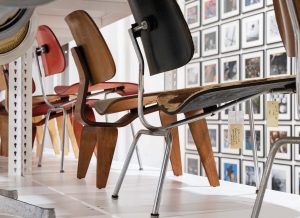
Shelves in the Collection Center present multiple iterations of Eames designs in varied materials, including the classic Lounge Chair
I have felt their presence in my own life. As an undergrad at Yale living in Morse College, one of a pair of student residence compounds by Ray’s best friend, architect Eero Saarinen, I loved reading — and napping — in the library’s Eames Lounge Chairs and Ottomans, the same furniture pair that is still a widely coveted (and copied) bestseller for the Herman Miller Furniture Company, its exclusive licensee since 1956. My aesthetically attuned wife Lynn brought into our marriage her elegant and cheerful deep-red-stained version of the petite Eames Molded Plywood Chair, created in 1946. And the ingenious Eames-designed interactive exhibit Mathematica: A World of Numbers… and Beyond — which debuted in 1961 at L.A.’s California Museum of Science and Industry and is now on view at the New York Hall of Science in Queens, Boston’s Museum of Science, and the Henry Ford Museum of American Innovation in Dearborn, Michigan — helped inspire my late brother Sid to become an award-winning high school and college math professor.
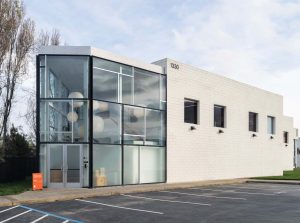
The Eames Archives occupies a 1997 building in Richmond, California, designed by San Francisco architect Jim Jennings. | Photos courtesy of the Eames Archives
So, when I learned that the Eames Archives — an impeccably organized, inventoried, and presented storehouse containing more than 40,000 (and growing) objects, artifacts, and ephemera sprung from the collaborative genius of Ray and Charles — had recently opened for 90-minute-long small-group guided tours, I felt as compelled to visit as a devotee does to pay homage at a shrine. On a rainy Wednesday morning, I crossed the bay via the Richmond-San Rafael Bridge to the archives’ home in a concise modern industrial building just off the freeway in Richmond.
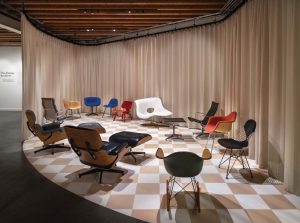
Before visitors leave the Archives tour, they’re invited to enjoy sitting in an assortment of now classic Eames designs, including two of the Lounge Chairs and Ottomans (lower left) and a white fiberglass La Chaise (top center) dating from 1948.
My pilgrimage proved enlightening, not least for the fact that, as most tours there are, it was led by Charles and Ray’s granddaughter, the warm and eloquent Llisa Demetrios, the archives’ chief curator as well as a working bronze sculptor. She welcomed visitors gathered in the small but airy foyer/gift shop and led us past large, cheerful photos of Ray and Charles into a spacious gallery featuring memorabilia from the couple’s educations and personal lives, along with some of their early collaborations.
This room offers the opportunity, Demetrios says, “to answer the questions we are asked most often: Who were Charles and Ray before they met? What was their first project together? And what else did they design besides furniture?” Among myriad highlights here, all lovingly explained by Demetrios, are artworks by the then Ray Kaiser, who first gained attention in the late 1930s as an Abstract Expressionist painter in New York under the tutelage of Hans Hofmann; an elaborate faux diploma filled with nonsense words, drawn for Charles by his friend, famed cartoonist Saul Steinberg, after Charles was dismissed from his architecture studies at Washington University in St. Louis for insisting that Frank Lloyd Wright be included on a timeline of the world’s great architects; and Ray’s charmingly meticulous illustrated packing lists for a trip the couple made to Europe. A display area in the room’s center features their early experiments in molded plywood, from battlefield litters that helped save soldiers’ lives and limbs during World War II, to abstract sculptures, to an early rendition of their whimsical elephant-shaped children’s chair, now made and marketed under license by the furnishings company Vitra.
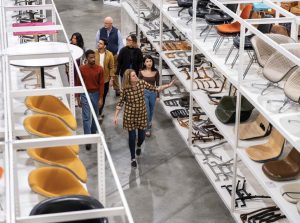
Llisa Demetrios, the Eameses’ granddaughter and chief curator of the Archives, explains the history and design strategy behind Charles and Ray’s classic works while guiding visitors through the vast exhibition space.
After allowing guests ample time to browse on their own, our guide next opened the doors to the vast main space of the Collections Center, containing aisle after aisle of tall industrial-style shelves neatly filled with every iteration of Eames furniture designs. Guests with a more global mindset can simply marvel at the variety, while those who savor minutiae might, for example, trace the evolution of a particular chair’s base design, materials, colors, finishes, or all manner of other nitty-gritty particulars. “One gets to see not just what was made but how it was made,” Demetrios says. “The collection is far more than the finished pieces of furniture with ‘design’ spelled with a capital ‘D.’ It is also about ‘design’ with a lower-case ‘d,’ which are the vast numbers of examples of Ray and Charles’ design process — iterations, prototypes, exploration of materials, chair jigs, scale models — that show all of the honing of an idea that leads to the finished pieces.” And Demetrios also shared such glimpses into the Eames Office design process as a flat-file drawer filled with silhouetted human photos at various scales to include in their elevation mockups or another containing orderly rainbows of colored pencils ready for use.
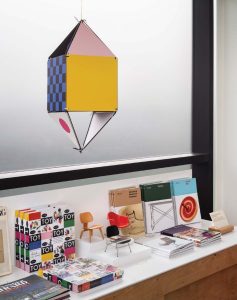
The gift shop features books on Eames designs, scale replicas of classic chairs by the couple, their favorite toys, and other memorabilia and souvenirs. Photos courtesy of the Eames Archives
Amidst all this curatorial order, a delightful wealth of seemingly random objects can also be found. On one section of wall hang three Art Nouveau-style bar signs from a set for the 1963 movie “Irma La Douce,” directed by the Eameses’ friend Billy Wilder, whose elaborately scripted and designed films led Charles to admiringly describe him as his “favorite architect.” Adjacent is a funhouse mirror, like those the couple placed near the seating they designed for the 1964 World’s Fair in New York so that children would stay amused while their parents took a break. There’s also a very limited-edition version of the chair and ottoman cast in gleaming stainless steel that captures every contour and fold of the molded-plywood-and-leather original. Visitors are invited to sit in it — so I can attest that, though very solid and chillingly cold, it’s also surprisingly comfortable.
On one high wall at the other side of the space is a two-story vertical xylophone that served as a doorbell at the Eames office in Santa Monica, California: When a visitor pressed the button (as one tour attendee was invited to do), a marble was released that, as it cascaded downward, played a tune composed for the couple by Oscar-winning film composer and conductor Elmer Bernstein (no relation to Leonard).
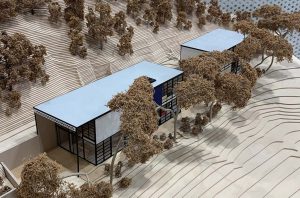
A three-dimensional architectural model of the Midcentury Eames House, Case Study House #8, shows how sensitively attuned the structure is to its bluffside site in Pacific Palisades, California. Photo: Norman Kolpas
On a large table are arrayed toys the couple loved to collect, including a wide assortment of children’s tops. “Toys are not really as innocent as they look,” Charles had said. “Toys and games are precursors to serious ideas.” On a more personal but equally playful note, Demetrios touchingly showed, and translated, a charming rebus letter her grandparents had sent her while on a trip to Arkansas.
This main part of the tour having concluded, our guide ushered us back into another area in the gallery, drawing back a curtain to reveal an assortment of Eames seating we were invited to sit in while pondering a final overview of her grandparents’ process: encapsulated in both Ray and Charles’s handwriting in a loosely hand-drawn Venn diagram, the three overlapping circles of which show “overlapping interests,” Demetrios explained. “The first circle was what Ray and Charles wanted to accomplish; the second represented their client; and the third was society as a whole. They found that the challenge is finding ways to work in the area where all three circles overlapped.”
As the Eames Archives so vividly and often movingly demonstrates, Charles and Ray Eames repeatedly and brilliantly succeeded at that goal.
Exploring the Eames Legacy
The Eames Archives is located at 1330 S. 51st St. in Richmond, California. Tours, limited to a maximum of 10 visitors, must be booked in advance and are held on Wednesdays, Thursdays, and Fridays, with tickets released for purchase at 10 a.m. Pacific time on the first of the month for tours the following month. Go to eamesinstitute.org/visit for more information and to book.
Other resources for Eames enthusiasts may also be found in California. The Mid-century Modern Eames House, Case Study House #8, designed and built by Charles and Ray in the late 1940s, and where they lived until their deaths, still stands in the Los Angeles community of Pacific Palisades at 203 Chautauqua Blvd., on a bluff above the Pacific Coast Highway. It was declared a National Historic Landmark in 2006. Although the interiors, which remain as they were when the couple lived there, are currently closed to visitors, the extensive, beautifully landscaped grounds may be toured, and the Eames Foundation staff keeps curtains open so people can glimpse inside. Guided exterior tours, available on Monday, Thursday, Friday, and Saturday, must be booked in advance at eamesfoundation.org.
The Eames Ranch, where the Eameses’ granddaughter Llisa Demetrios grew up and still lives, is based outside the Sonoma County town of Petaluma, California. It is the headquarters of the Eames Institute of Infinite Curiosity (eamesinstitute.org), which administers the Eames Archives and has an “overarching goal,” says Demetrios, “to unpack the way that Charles and Ray Eames worked, the way they infused their designs and lives with curiosity and discovery at every turn to solve problems at any scale.” It shares a wealth of research and ideas through its online Kazam! Magazine, accessible via the institute’s website. While currently not open to the public, the ranch functions as a “living laboratory” dedicated to working with nonprofits, conservationists, and educators to “explore, test, and refine ideas and mechanisms for use in land stewardship, habitat restoration, farming, and ranching.”
Based in Marin County, California, Norman Kolpas is the managing editor of Western Art & Architecture and the author of more than 40 books and hundreds of articles. He also teaches nonfiction writing in The Writers’ Program at UCLA Extension.






No Comments